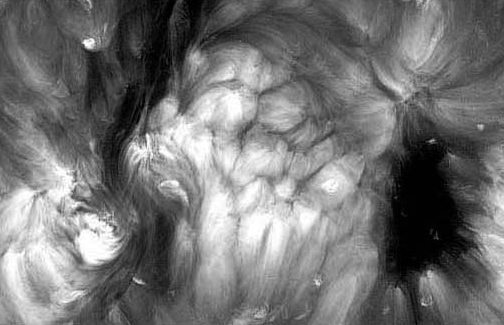There’s something new under the Sun… well, just above the Sun, actually. Scientists at the Naval Research Laboratory have spotted structures in the Sun’s super-hot corona that may shed some light on the way its magnetic fields evolve — especially near the edges of vast, wind-spewing coronal holes.
Coronal holes are regions where the Sun’s magnetic field doesn’t loop back down but rather streams outward into space. Appearing dark in images captured in ultraviolet wavelengths, these holes in the corona allow solar material to flow directly out into the solar system, in many cases doubling the normal rate of the solar wind.
Recently witnessed by NRL researchers using NASA’s SDO and STEREO solar-observing spacecraft, features calledcoronal cells exist at the boundaries of coronal holes and may be closely associated with their formation and behavior.
The coronal cells are plumes of magnetic activity that stream upward from the Sun, occurring in clusters. Likened to “candles on a birthday cake”, the incredibly hot (1 million K) plumes extend outwards, punching though the lower corona.
Seen near the center of the Sun’s disk, the cells appear structurally similar to granules — short-lived areas of rising and falling solar material on the Sun’s photosphere — but seen from an angle via STEREO, the cells were witnessed to be much larger, elongated and extending higher into the Sun’s atmosphere. For comparison, granules are typically about 1,000 km in diameter while the coronal cells have been measured at 30,000 km across.
“We think the coronal cells look like flames shooting up, like candles on a birthday cake,” said Neil Sheeley, a solar scientist at the Naval Research Laboratory in Washington, D.C. ”When you see them from the side, they look like flames. When you look at them straight down they look like cells. And we had a great way of checking this out, because we could look at them from the top and from the side at the same time using observations from SDO, STEREO-A, and STEREO-B.”
Watch a video below of cells made from images acquired by STEREO-B… note how their elongated structure becomes evident as the cells rotate closer to the Sun’s limb.
NRL researchers also noted that the coronal cells appeared when adjacent coronal holes closed and disappeared when the holes opened, suggesting that the holes and cells share the same magnetic structure. In addition, the coronal cells were seen to disappear when a solar filament would erupt nearby, being “extinguished” as the cooler strand of solar material moved across them. Once the filament passed, the cells reformed — again, indicating a direct magnetic association.
The coronal cells were also identified in earlier images from ESA and NASA’s SOHO and Japan’sHinode spacecraft.
It’s hoped that further study of these candle-like structures will lead to more knowledge of our star’s complex magnetic field and the effects it has on space weather and geomagnetic activity experienced here on Earth.
Source: Universe Today

No hay comentarios:
Publicar un comentario